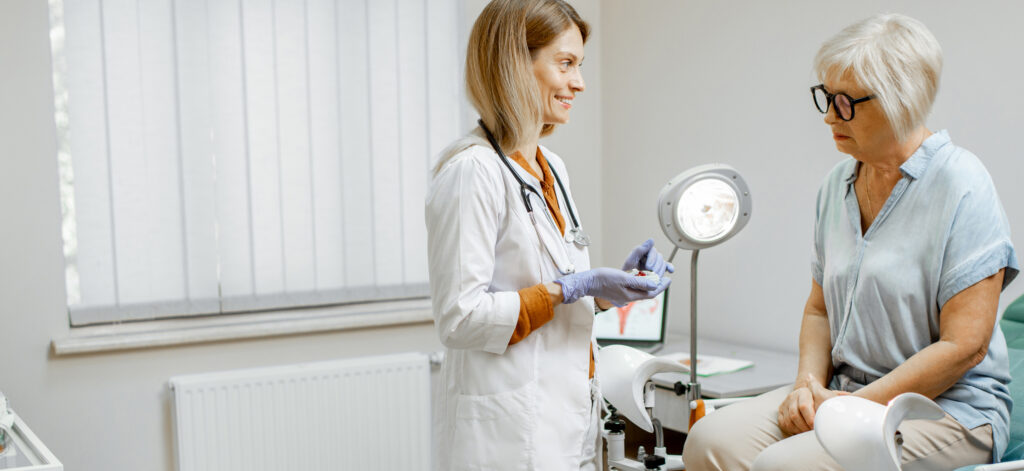
Estimated reading time: 5 minutes
Medically reviewed and verified by Kate Burke, MD, MHA
If you have been diagnosed with diabetes, protecting your eye health is critical! Diabetic macular edema (DME) is a common cause of vision loss among people with diabetic retinopathy, a complication of diabetes that damages blood vessels in the back of the eye. Fortunately, early diagnosis and treatment of DME can help prevent or reduce its effects. The main way to catch this condition early is through an eye exam! So if you have diabetes, what should you expect during an eye exam for DME? Here is an overview from PatientsLikeMe.

DME and Eye Exams
DME typically can occur at any stage of diabetic retinopathy, however not all patients with diabetic retinopathy will develop DME. It develops when high blood sugar levels harm the blood vessels in the retina, which is the light-sensitive layer in the back of the eye. If these damaged blood vessels leak fluid into the macula, the part of the retina responsible for sharp, central vision, the resulting swelling can distort or damage vision. You need regular eye exams to catch and address this condition early.
To make sure your visit goes smoothly:
- Bring a list of medications and any symptoms you’ve noticed.
- Arrange for someone to drive you home, as the dilation drops may temporarily blur your vision.
- Wear sunglasses to reduce light sensitivity after the exam.
Tests and Procedures
When an eye doctors suspects DME, they will perform a comprehensive eye exam to confirm the diagnosis and assess the severity of the condition. This consists of a few different parts.
Dilated-Eye Exam
A dilated-eye exam is a cornerstone of diagnosing diabetic eye conditions. A doctor will apply special eye drops to enlarge your pupils. This lets your doctor examine the retina and macula closely. They are looking for fluid buildup, swelling, or other abnormalities in the retina and macula. The drops may cause blurred vision and light sensitivity for a short duration after. Be sure to bring sunglasses for after the exam.
Fluorescein Angiogram (FA)
This test helps your doctor check the blood flow in the retina and find any leaking blood vessels. They will inject a yellow dye into a vein in your arm. The dye travels to your eyes, where it highlights blood vessels for imaging with a special camera. The images will reveal whether and where fluid is leaking from damaged blood vessels in your retina. There can be some temporary side effects, including a yellowish tint to your skin or urine and mild nausea.
Optical Coherence Tomography (OCT)
OCT is a non-invasive imaging test that looks at the thickness of the retina and detects swelling. In this test, you will rest your chin on a machine while it scans your eyes using light waves. The test is quick and painless, lasting about 10–15 minutes. Doctors are looking at detailed cross-section images of your retina. These will show the presence and extent of macular swelling.
Visual Acuity Test
This test measures how well you can see. When you think of a classic eye exam, with a chart that has letters of various sizes, this is what you are imagining. In a visual acuity test, you read letters of various sizes on an eye chart from 20 feet away, covering one eye at a time. Doctors are checking for any changes or loss in your central vision that may indicate macular damage.
Amsler Grid Test
The Amsler grid looks for distortions in your central vision. In this test, you will look at a grid resembling graph paper with a dark center dot and describe any wavy or missing lines. Any irregularities in the grid pattern may signal macular problems, including DME.
Intraocular Pressure Test (Glaucoma Screening)
People with diabetes are also at risk for another eye condition called glaucoma, which is often screened during diabetic eye exams. Here, doctors use a device called a tonometer. With it they will either gently touch your eye or blow a puff of air to measure eye pressure. They are looking for elevated pressure that indicate glaucoma, which requires separate management.
Diagnosing DME
After completing these tests, your doctor will review the results to determine whether you have DME. If diagnosed, the next steps may include discussing treatment options to manage the condition and preserve your vision.
Treatment Options for DME
Treatment for DME focuses on reducing swelling in the macula and preventing further vision loss. Common treatments include:
- Anti-VEGF Injections: These medications block a protein that contributes to abnormal blood vessel growth and leakage.
- Corticosteroids: These reduce inflammation and swelling in the macula.
- Laser Therapy: In some cases, laser treatment can seal leaking blood vessels.
Your doctor will recommend the most appropriate treatments based on the severity of your condition and your overall health.

A comprehensive eye exam is crucial for diagnosing diabetic macular edema early and preserving your vision. Understanding what to expect can help you feel more comfortable and prepared. If you have diabetes, don’t wait—schedule regular eye exams and talk to your doctor about any vision changes. Early detection and treatment can make a significant difference in maintaining your quality of life.
Take charge of your health with PatientsLikeMe, the innovative platform that empowers you to manage your wellness journey with confidence. Connect with others who share similar health experiences and gain access to their valuable insights and support. With PatientsLikeMe, you can easily track your symptoms, treatments, and outcomes, making it simpler to make informed decisions and communicate effectively with your healthcare team.

